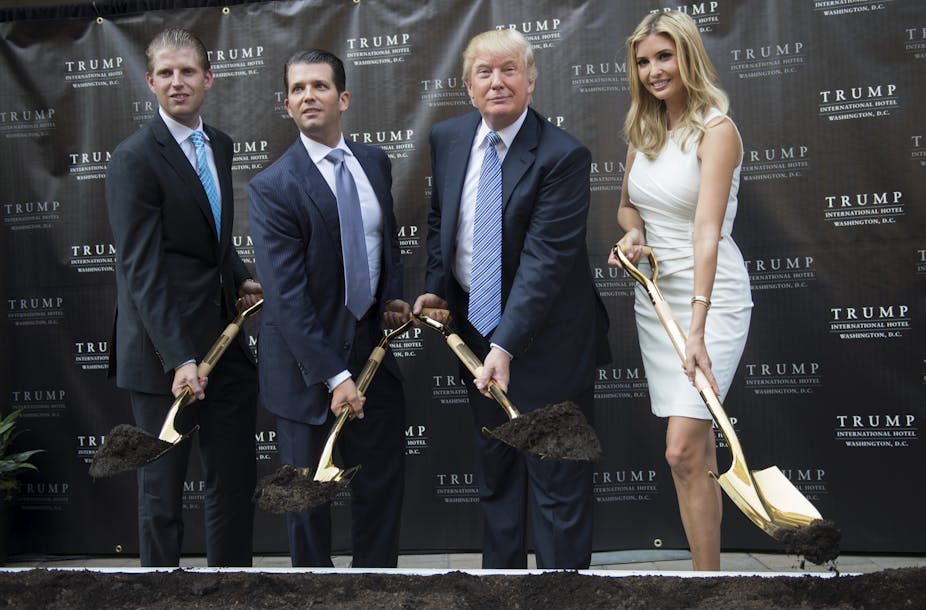Most family businesses don’t have to work out how they will survive the boss taking over as president of the United States. Donald Trump has been forced to distance himself from the family firm since winning the US election. He even said: “I don’t care about my company. It doesn’t matter. My kids run it.” It is perhaps an extreme example of the pressures that swirl around the businesses at the heart of many economies, but it does signal the unique pressures which come to bear when trying to sustain an organisation through the generations.
Family businesses cross a variety of cultures, religions and backgrounds. The chocolate manufacturers Rowntree’s, Fry’s and Cadbury’s, the shoemakers Clarks and the bankers Barclays and Lloyds all became large businesses after being started by Quaker families. They went into business in part because they were excluded from other aspects of public life in the 18th and 19th centuries, and along the way earned a reputation for looking after their workforces.
More recent examples include small, local family retailers set up by South Asian immigrants in the UK who want to support the next generation either in the business or in another profession.
Crash
Family businesses can last a long time. While trying to make gold from base metals, an Armenian alchemist discovered a different type of “gold” – a metal alloy that had outstanding sound quality and power when made into musical cymbals. A few years later, in 1623, the Zildjian Cymbal Company was founded, and can be traced through 16 generations and nearly four centuries to today’s firm in Massachusetts.

Many key family businesses have survived the test of time after opening ownership beyond the family, although often the original families still control a significant stake in the company. The list includes modern-day giants like Wal-Mart Stores and Ford Motors in the US, L’Oreal in France, Benetton in Italy, Samsung in Korea, Sainsbury’s in the UK and Siemens in Germany.
The Indian company Tata has, however, recently been suffering in the media glare due to an acrimonious falling out between family members in senior positions.
The fact is that most businesses are family owned. In the UK some 71% of all small and medium-sized enterprises (SMEs) which employ up to 250 people are family owned. Given those multinational success stories above, it might be surprising to learn that up to 95% do not survive in family ownership by the third generation.

Some reasons for this may lie in the common criticisms of family businesses. They have been accused of sometimes having poor management and discipline, inadequate funding to support growth, differing incentives between family members and a lack of formalised practices and procedures. They can fall foul of time consuming family conflict, slow decision making, risk avoidance, limited innovation and a strategy which favours the status quo rather than change.
Multiple motivations
So how do you build a sustainable family businesses? First, it is important to consider how the rationalities underpinning the behaviours and strategies of family firms vary from those of others, especially small businesses. Let’s assume that a well-run SME is driven entirely by “market rationalities” which focus entirely on business needs and without the interference of motivations linked to the family ownership. It can be argued then that family businesses are more likely to be profit satisficers (balancing other objectives with achieving a minimum level of profit) rather than profit maximisers.
Relationships between family members – both good and bad, or short and long term – can carry over into the business and influence how things are decided. These challenge assumptions of purely economic rational decision making in family firms, particularly when combined with cognitive and behavioural biases such as preferring those who are like us, or feeling that the value of a loss is much more than that of an equivalent gain.

One way of looking at family firms suggests that we should accept that the family, business and social lives of those running a company must be seen as operating together: relationships overlap; family, friends and business logic or rationalities combine to influence behaviour and decision-making.
Fundamentally, family aims and values can result in business decisions that differ from non-family firms. They may be reluctant to hire people from outside the family or they may adopt technology in a less flexible way as they are tied to existing ways of doing things and to existing staff and other assets.
Supporting family businesses
One implication is that support for small businesses, and companies with high growth potential, should not assume that family and other firms are identical. It may be that policies need to be carefully adapted for family firms.
Support such as stimulating demand, changing public attitudes towards entrepreneurship, supporting research and development and the take-up of new technology, as well as providing training, advice and financial assistance all need to be adapted to take account of the differences between family and non-family firms. Emphasis also needs to be placed on developing partnerships and engagement with others, including family members and employees.
Success for family businesses should not be considered just in terms of survival. A few family businesses will develop into future market leaders even if their ownership changes, and these need to be nurtured. As family businesses make up such a crucial part of both everyday and high growth firms, research and policies need to consider those more rounded perspectives that incorporate the complex bonds and motivations that mark family firms out from the rest. Fortunately, not all will have to factor in a startling political rise that leaves the owner preparing to move into the White House amid a media furore about many potential conflicts of interest.

